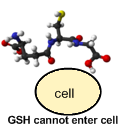|
N-acetylcysteine, the critical precursor to glutathione synthesisN-acetylcysteine or NAC is the amino acid cysteine with an acetyl group attached to it. The acetyl group makes the NAC easily absorbed by the body and distributed to its different parts.
N-acetylcysteine is not found in food. It has to be ingested through oral supplementation. What does N-acetylcysteine do? N-acetyl cysteine is an antioxidant and a precursor to intracellular glutathione synthesis. Glutathione, on the other hand, is the predominant antioxidant in cells. Virtually all cells need glutathione to function. What are the uses of N-acetylcysteine? N-acteyl cysteine or NAC is used in hospital as an antidote to acetaminophen poisoning. NAC is also ised to improve the symptoms and recurrences in people with chronic bronchitis. This is due to NAC's ability to break down mucus. In fact, NAC has been used as a mucolytic drug for more than 30 years.[European Respiratory Journal; De Flora,S, 10(7):1535-1541(1997)] NAC has also been found to prevent influenza (flu) infections at a 1200mg daily dosage. A study of 268 subjects was conducted in 1997 about the effect of long-term n-acetylcysteine treatment on influenza and influenza-like episodes. In the study, the subjects were given either placebo or two daily doses of 600mg NAC for 6 months. Those given NAC had significantly reduced influenza-like symptoms (25%) than the placebo (79%). [European Respiratory Journal; De Flora,S,10(7):1535-1541(1997)] Another use of NAC is in treating liver failure from causes other than acetaminophen poisoning. Hepatitis is an example of liver failure where supplementation may be of help. Furthermore, NAC has been found to reduce the inflammatory symptoms of chronic obstructive pulmonary disease or COPD. A study shows that n-acetylcysteine helps protect the lungs by its antioxidant action as well as its role as a precursor to the master antioxidant glutathione. [European Respiratory Journal;Dekhuizjen,PNR;23:629-636 (2004)] Deficiencies of NAC has not been defined. Deficiencies of the amino acid cysteine, however, has been reported in HIV patients. This is why NAC is currently being investigated as a treatment of AIDS. N-acetylcysteine as a precursor of Glutathione Synthesis N-acetylcysteine is an acteylated form of cysteine. Cysteine,on the other hand, is one of the three precursors of glutathione synthesis. Let's the review the process of glutathione synthesis: Step 1: GLUTAMATE + CYSTEINE + gamma-glutamylcysteine synthetase Step 2: Glutamylcysteine + GLYCINE + GSH synthetase End Product: GLUTATHIONE Cysteine is the rate-limiting factor in glutathione synthesis since the other glutathione precursors, glycine and glutamic acid, are found abundantly in the body. Cysteine, in itself, is not very soluble in water. And it is not easily absorbed by the intestines. This is why, in order to boost intacellular glutathione, the acetylated form of cysteine or n-acetylcysteine is taken. N-acetylcysteine or NAC readily enters cells where it is converted to cysteine. It is this cysteine that is now used in the production of glutathione in cells. Apart from NAC, a dietary source of cysteine, whey protein, is a possible glutathione booster though evidence on humans is inadequate. One recent study in 2007 showed that pressurized whey protein supplementation of 45 g/day for 2 weeks can increase lymphocyte glutathione by 24%. [International Journal of Food Sciences and Nutrition;Zavorsky,G. et al;58(6):429-436(2007)] Why take NAC instead of glutathione itself? 
Oral glutathione is poorly absorbed by the body. And even if it can pass through the stomach and intestines, it cannot enter the cells where it is needed.The glutathione molecule itself is too big. This is why instead of taking glutathione directly, n-acetylcysteine is taken. NAC is readily converted to cysteine, which is the important precursor of glutathione. Glutathione is the body's master antioxidant and detoxifier. As such, it has been found to reduce intracellular inflammation which is the root cause of diseases. Return from n-acetylcysteine to Glutathione Sources. Return to
|






